Corporate Finance Report: Capital Structure Impact on WACC at Dynamic
VerifiedAdded on 2023/06/03
|22
|5317
|418
Report
AI Summary
This corporate finance report critically examines a company's capital structure and weighted average cost of capital (WACC) under various scenarios, including changes in debt levels and the introduction of a tax rate. It begins by calculating the market debt-to-equity ratio, cost of levered equity, and current WACC in a perfect market, demonstrating that capital structure is irrelevant in such conditions. The report then analyzes the impact of issuing stock to repurchase debt and introduces a tax rate of 40% along with additional debt issuance to repurchase stock, revealing how these factors influence the WACC in an imperfect market. Furthermore, the report includes an analysis of initial investment outlay, terminal cash flow, and the treatment of working capital for a project, along with a discussion on the evaluation of corporate lifecycle and benefits of different types of financing. Desklib offers this document along with many others to aid students in their studies.

CORPORATE
FINANCE
FINANCE
Paraphrase This Document
Need a fresh take? Get an instant paraphrase of this document with our AI Paraphraser
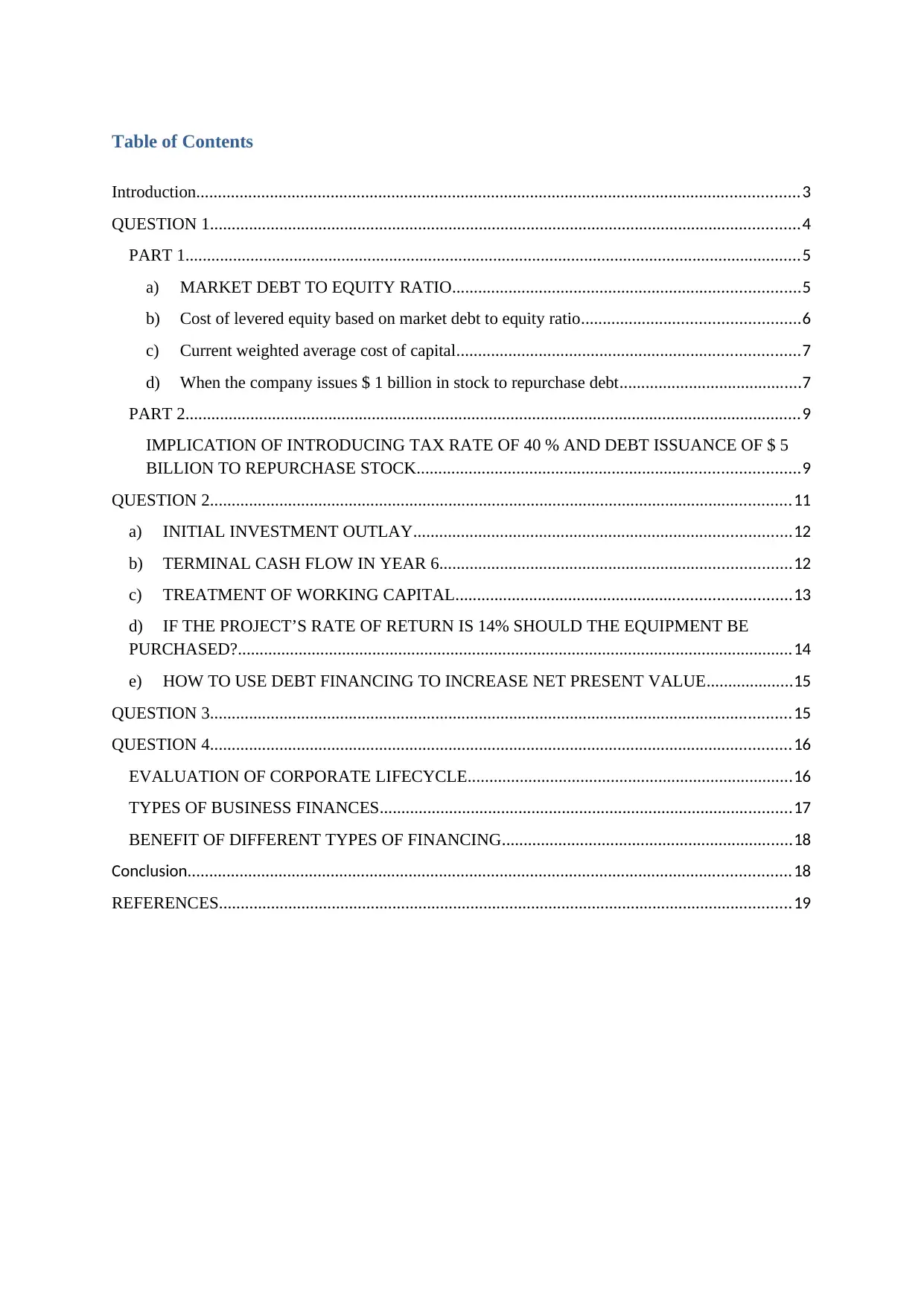
Table of Contents
Introduction...........................................................................................................................................3
QUESTION 1........................................................................................................................................4
PART 1..............................................................................................................................................5
a) MARKET DEBT TO EQUITY RATIO................................................................................5
b) Cost of levered equity based on market debt to equity ratio..................................................6
c) Current weighted average cost of capital...............................................................................7
d) When the company issues $ 1 billion in stock to repurchase debt..........................................7
PART 2..............................................................................................................................................9
IMPLICATION OF INTRODUCING TAX RATE OF 40 % AND DEBT ISSUANCE OF $ 5
BILLION TO REPURCHASE STOCK........................................................................................9
QUESTION 2......................................................................................................................................11
a) INITIAL INVESTMENT OUTLAY.......................................................................................12
b) TERMINAL CASH FLOW IN YEAR 6.................................................................................12
c) TREATMENT OF WORKING CAPITAL.............................................................................13
d) IF THE PROJECT’S RATE OF RETURN IS 14% SHOULD THE EQUIPMENT BE
PURCHASED?................................................................................................................................14
e) HOW TO USE DEBT FINANCING TO INCREASE NET PRESENT VALUE....................15
QUESTION 3......................................................................................................................................15
QUESTION 4......................................................................................................................................16
EVALUATION OF CORPORATE LIFECYCLE...........................................................................16
TYPES OF BUSINESS FINANCES...............................................................................................17
BENEFIT OF DIFFERENT TYPES OF FINANCING...................................................................18
Conclusion...........................................................................................................................................18
REFERENCES....................................................................................................................................19
Introduction...........................................................................................................................................3
QUESTION 1........................................................................................................................................4
PART 1..............................................................................................................................................5
a) MARKET DEBT TO EQUITY RATIO................................................................................5
b) Cost of levered equity based on market debt to equity ratio..................................................6
c) Current weighted average cost of capital...............................................................................7
d) When the company issues $ 1 billion in stock to repurchase debt..........................................7
PART 2..............................................................................................................................................9
IMPLICATION OF INTRODUCING TAX RATE OF 40 % AND DEBT ISSUANCE OF $ 5
BILLION TO REPURCHASE STOCK........................................................................................9
QUESTION 2......................................................................................................................................11
a) INITIAL INVESTMENT OUTLAY.......................................................................................12
b) TERMINAL CASH FLOW IN YEAR 6.................................................................................12
c) TREATMENT OF WORKING CAPITAL.............................................................................13
d) IF THE PROJECT’S RATE OF RETURN IS 14% SHOULD THE EQUIPMENT BE
PURCHASED?................................................................................................................................14
e) HOW TO USE DEBT FINANCING TO INCREASE NET PRESENT VALUE....................15
QUESTION 3......................................................................................................................................15
QUESTION 4......................................................................................................................................16
EVALUATION OF CORPORATE LIFECYCLE...........................................................................16
TYPES OF BUSINESS FINANCES...............................................................................................17
BENEFIT OF DIFFERENT TYPES OF FINANCING...................................................................18
Conclusion...........................................................................................................................................18
REFERENCES....................................................................................................................................19

Introduction
The financial leverage and cost of capital are the two important aspects for the
effective business functioning. It is required to set up strong harmonization between both if
company wants to sustain its business in long run. This report has reflected that key
understanding on the optimum capital structure based on the cost of capital and financial
leverage of company. Financial leverage shows the business sustainability risk of company if
it fails to have enough earnings before interest and tax and its interest coverage out of the
available earning. This report has reflected the cost of levered equity, debt funding, capital
structure and use of the capital budgeting tools to determine the terminal values, initial
investment and cash flow for the accepted business projects.
The financial leverage and cost of capital are the two important aspects for the
effective business functioning. It is required to set up strong harmonization between both if
company wants to sustain its business in long run. This report has reflected that key
understanding on the optimum capital structure based on the cost of capital and financial
leverage of company. Financial leverage shows the business sustainability risk of company if
it fails to have enough earnings before interest and tax and its interest coverage out of the
available earning. This report has reflected the cost of levered equity, debt funding, capital
structure and use of the capital budgeting tools to determine the terminal values, initial
investment and cash flow for the accepted business projects.
⊘ This is a preview!⊘
Do you want full access?
Subscribe today to unlock all pages.

Trusted by 1+ million students worldwide

QUESTION 1
CRITICAL EXAMINATION OF COMPANY’S CAPITAL STRUCTURE
Given,
Particulars Amount or number
Short-term debt (inclusive of current portion
of long term debt)
$ 2,000,000,000
Long term debt $ 4,000,000,000
Total shareholder’s equity $ 10,000,000,000
Number of ordinary shares outstanding 2,500,000,000
Current stock price $ 30
Current yield to maturity on stocks (RD) 3%
Cost of unleveraged equity under current
market situations (RU)
12%
Industry average market debt to equity ratio 17.5%
This above given information is given in the report and on the basis of the same rest
computation is made.
Computation is done as below.
CRITICAL EXAMINATION OF COMPANY’S CAPITAL STRUCTURE
Given,
Particulars Amount or number
Short-term debt (inclusive of current portion
of long term debt)
$ 2,000,000,000
Long term debt $ 4,000,000,000
Total shareholder’s equity $ 10,000,000,000
Number of ordinary shares outstanding 2,500,000,000
Current stock price $ 30
Current yield to maturity on stocks (RD) 3%
Cost of unleveraged equity under current
market situations (RU)
12%
Industry average market debt to equity ratio 17.5%
This above given information is given in the report and on the basis of the same rest
computation is made.
Computation is done as below.
Paraphrase This Document
Need a fresh take? Get an instant paraphrase of this document with our AI Paraphraser
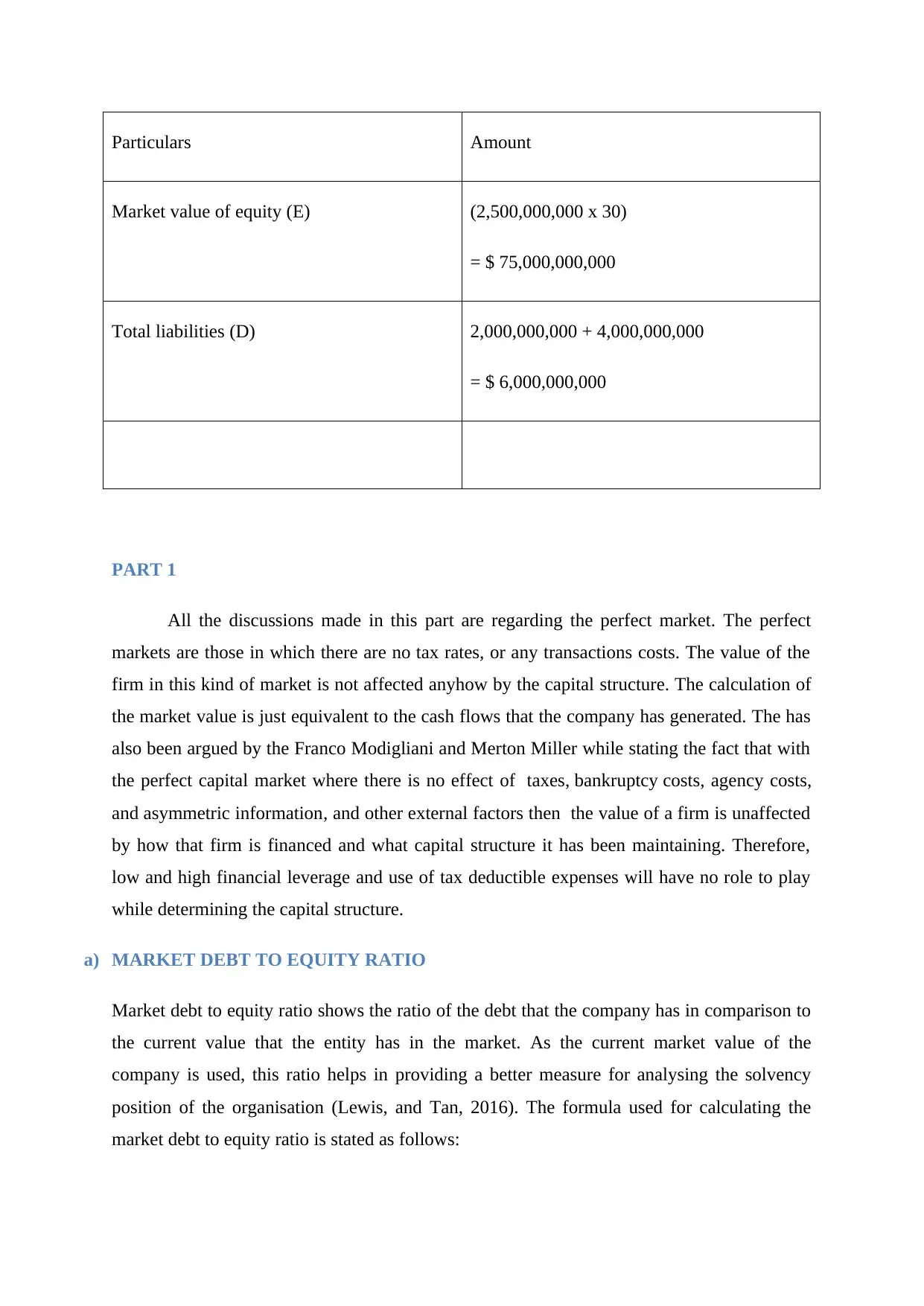
Particulars Amount
Market value of equity (E) (2,500,000,000 x 30)
= $ 75,000,000,000
Total liabilities (D) 2,000,000,000 + 4,000,000,000
= $ 6,000,000,000
PART 1
All the discussions made in this part are regarding the perfect market. The perfect
markets are those in which there are no tax rates, or any transactions costs. The value of the
firm in this kind of market is not affected anyhow by the capital structure. The calculation of
the market value is just equivalent to the cash flows that the company has generated. The has
also been argued by the Franco Modigliani and Merton Miller while stating the fact that with
the perfect capital market where there is no effect of taxes, bankruptcy costs, agency costs,
and asymmetric information, and other external factors then the value of a firm is unaffected
by how that firm is financed and what capital structure it has been maintaining. Therefore,
low and high financial leverage and use of tax deductible expenses will have no role to play
while determining the capital structure.
a) MARKET DEBT TO EQUITY RATIO
Market debt to equity ratio shows the ratio of the debt that the company has in comparison to
the current value that the entity has in the market. As the current market value of the
company is used, this ratio helps in providing a better measure for analysing the solvency
position of the organisation (Lewis, and Tan, 2016). The formula used for calculating the
market debt to equity ratio is stated as follows:
Market value of equity (E) (2,500,000,000 x 30)
= $ 75,000,000,000
Total liabilities (D) 2,000,000,000 + 4,000,000,000
= $ 6,000,000,000
PART 1
All the discussions made in this part are regarding the perfect market. The perfect
markets are those in which there are no tax rates, or any transactions costs. The value of the
firm in this kind of market is not affected anyhow by the capital structure. The calculation of
the market value is just equivalent to the cash flows that the company has generated. The has
also been argued by the Franco Modigliani and Merton Miller while stating the fact that with
the perfect capital market where there is no effect of taxes, bankruptcy costs, agency costs,
and asymmetric information, and other external factors then the value of a firm is unaffected
by how that firm is financed and what capital structure it has been maintaining. Therefore,
low and high financial leverage and use of tax deductible expenses will have no role to play
while determining the capital structure.
a) MARKET DEBT TO EQUITY RATIO
Market debt to equity ratio shows the ratio of the debt that the company has in comparison to
the current value that the entity has in the market. As the current market value of the
company is used, this ratio helps in providing a better measure for analysing the solvency
position of the organisation (Lewis, and Tan, 2016). The formula used for calculating the
market debt to equity ratio is stated as follows:
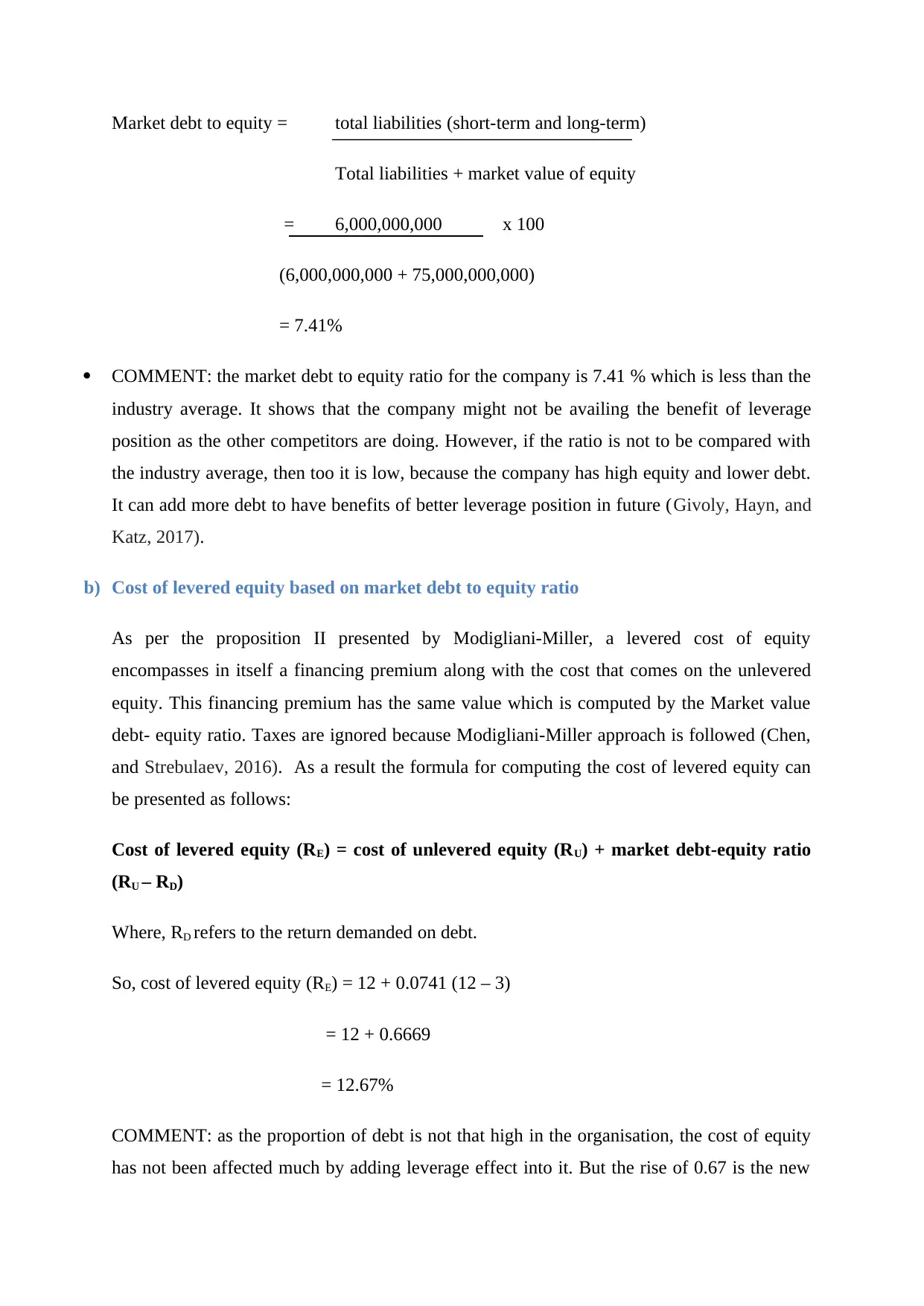
Market debt to equity = total liabilities (short-term and long-term)
Total liabilities + market value of equity
= 6,000,000,000 x 100
(6,000,000,000 + 75,000,000,000)
= 7.41%
COMMENT: the market debt to equity ratio for the company is 7.41 % which is less than the
industry average. It shows that the company might not be availing the benefit of leverage
position as the other competitors are doing. However, if the ratio is not to be compared with
the industry average, then too it is low, because the company has high equity and lower debt.
It can add more debt to have benefits of better leverage position in future (Givoly, Hayn, and
Katz, 2017).
b) Cost of levered equity based on market debt to equity ratio
As per the proposition II presented by Modigliani-Miller, a levered cost of equity
encompasses in itself a financing premium along with the cost that comes on the unlevered
equity. This financing premium has the same value which is computed by the Market value
debt- equity ratio. Taxes are ignored because Modigliani-Miller approach is followed (Chen,
and Strebulaev, 2016). As a result the formula for computing the cost of levered equity can
be presented as follows:
Cost of levered equity (RE) = cost of unlevered equity (RU) + market debt-equity ratio
(RU – RD)
Where, RD refers to the return demanded on debt.
So, cost of levered equity (RE) = 12 + 0.0741 (12 – 3)
= 12 + 0.6669
= 12.67%
COMMENT: as the proportion of debt is not that high in the organisation, the cost of equity
has not been affected much by adding leverage effect into it. But the rise of 0.67 is the new
Total liabilities + market value of equity
= 6,000,000,000 x 100
(6,000,000,000 + 75,000,000,000)
= 7.41%
COMMENT: the market debt to equity ratio for the company is 7.41 % which is less than the
industry average. It shows that the company might not be availing the benefit of leverage
position as the other competitors are doing. However, if the ratio is not to be compared with
the industry average, then too it is low, because the company has high equity and lower debt.
It can add more debt to have benefits of better leverage position in future (Givoly, Hayn, and
Katz, 2017).
b) Cost of levered equity based on market debt to equity ratio
As per the proposition II presented by Modigliani-Miller, a levered cost of equity
encompasses in itself a financing premium along with the cost that comes on the unlevered
equity. This financing premium has the same value which is computed by the Market value
debt- equity ratio. Taxes are ignored because Modigliani-Miller approach is followed (Chen,
and Strebulaev, 2016). As a result the formula for computing the cost of levered equity can
be presented as follows:
Cost of levered equity (RE) = cost of unlevered equity (RU) + market debt-equity ratio
(RU – RD)
Where, RD refers to the return demanded on debt.
So, cost of levered equity (RE) = 12 + 0.0741 (12 – 3)
= 12 + 0.6669
= 12.67%
COMMENT: as the proportion of debt is not that high in the organisation, the cost of equity
has not been affected much by adding leverage effect into it. But the rise of 0.67 is the new
⊘ This is a preview!⊘
Do you want full access?
Subscribe today to unlock all pages.

Trusted by 1+ million students worldwide

demand which the shareholders are expecting for their investments and returns on the same
gets riskier after debt are introduced in the company. Even though the equity returns are
increased after debts are introduced, still more risk comes uninvited (Boyer, Lim, and Lyons,
2017).
c) Current weighted average cost of capital
Weighted average cost of capital helps in computing a cost rate that is equal to the weighted
average of the cost which is incurred on debt and the equity (Frank, and Shen, 2016).
Formula:
Weighted average cost of capital (WACC/RWACC) = {E/ (E+D)} X RE + {D/ (E+D)} X RD
= 75,000,000,000 x 0.1267 6,000,000,000
x .03
(75,000,000,000 + 6,000,000,000) (75,000,000,000 + 6,000,000,000)
= {0.9259 x 0.1267} + {0.0741 x 0.03}
= 0.1173 + 0.0022
= 12 %
COMMENT: the above calculation shows that the company is operating in a perfect capital
market. This is so because as per Modigliani-Miller when the capital markets are perfect, the
capital structure of the organisation has no effect on the firm’s WACC, and the same tends
equal to firm’s unlevered cost of equity, which is 12 % in this case (Garcia, Saravia, and
Yepes, 2016).
d) When the company issues $ 1 billion in stock to repurchase debt
When the company issues $ 1 billion stock and repurchases debt, the situation comes as
follows:
Particulars Amount
gets riskier after debt are introduced in the company. Even though the equity returns are
increased after debts are introduced, still more risk comes uninvited (Boyer, Lim, and Lyons,
2017).
c) Current weighted average cost of capital
Weighted average cost of capital helps in computing a cost rate that is equal to the weighted
average of the cost which is incurred on debt and the equity (Frank, and Shen, 2016).
Formula:
Weighted average cost of capital (WACC/RWACC) = {E/ (E+D)} X RE + {D/ (E+D)} X RD
= 75,000,000,000 x 0.1267 6,000,000,000
x .03
(75,000,000,000 + 6,000,000,000) (75,000,000,000 + 6,000,000,000)
= {0.9259 x 0.1267} + {0.0741 x 0.03}
= 0.1173 + 0.0022
= 12 %
COMMENT: the above calculation shows that the company is operating in a perfect capital
market. This is so because as per Modigliani-Miller when the capital markets are perfect, the
capital structure of the organisation has no effect on the firm’s WACC, and the same tends
equal to firm’s unlevered cost of equity, which is 12 % in this case (Garcia, Saravia, and
Yepes, 2016).
d) When the company issues $ 1 billion in stock to repurchase debt
When the company issues $ 1 billion stock and repurchases debt, the situation comes as
follows:
Particulars Amount
Paraphrase This Document
Need a fresh take? Get an instant paraphrase of this document with our AI Paraphraser

Market value of equity (E) (2,500,000,000 x 30) + 1,000,000,000
= $ 76,000,000,000
Total liabilities (D) 2,000,000,000 + 4,000,000,000 –
1,000,000,000
= $ 5,000,000,000
COST OF LEVERED EQUITY BASED ON MARKET DEBT TO EQUITY RATIO
For this market debt to equity is to be recalculated. It can be done as follows:
Market debt to equity = 5,000,000,000
(5,000,000,000 + 76,000,000,000)
= 6.17 %
COMMENT: the debt in comparison to equity has further reduced.
COST OF LEVERED EQUITY BASED ON MARKET DEBT TO EQUITY RATIO
The cost of levered equity comes to (new RE) = 12 + 0.0617 (12 – 3)
= 12.43%
COMMENT: the lessening of debt in the capital structure do not does away with the risks.
Risks are present till the date debts are there and hence results in increasing the return
demanded by the shareholders.
WEIGHTED AVERAGE COST OF CAPITAL
The weighted average cost of capital is computed as follows:
New WACC (new RWACC)
= 76,000,000,000 x 0.1243 5,000,000,000
x .03
(76,000,000,000 + 5,000,000,000) (76,000,000,000 + 5,000,000,000)
= 12 %
= $ 76,000,000,000
Total liabilities (D) 2,000,000,000 + 4,000,000,000 –
1,000,000,000
= $ 5,000,000,000
COST OF LEVERED EQUITY BASED ON MARKET DEBT TO EQUITY RATIO
For this market debt to equity is to be recalculated. It can be done as follows:
Market debt to equity = 5,000,000,000
(5,000,000,000 + 76,000,000,000)
= 6.17 %
COMMENT: the debt in comparison to equity has further reduced.
COST OF LEVERED EQUITY BASED ON MARKET DEBT TO EQUITY RATIO
The cost of levered equity comes to (new RE) = 12 + 0.0617 (12 – 3)
= 12.43%
COMMENT: the lessening of debt in the capital structure do not does away with the risks.
Risks are present till the date debts are there and hence results in increasing the return
demanded by the shareholders.
WEIGHTED AVERAGE COST OF CAPITAL
The weighted average cost of capital is computed as follows:
New WACC (new RWACC)
= 76,000,000,000 x 0.1243 5,000,000,000
x .03
(76,000,000,000 + 5,000,000,000) (76,000,000,000 + 5,000,000,000)
= 12 %

COMMENT: hence, there is no impact of change in the capital structure on the weighted
average cost of capital of the organisation. It is still 12%. The reason is same. The perfect
capita markets are not affected by any change that happens in the capital structure of the
organisation. The weighted average cost of capital always comes equal to the unlevered cost
of equity (Arrow, 2017).
PART 2
IMPLICATION OF INTRODUCING TAX RATE OF 40 % AND DEBT ISSUANCE
OF $ 5 BILLION TO REPURCHASE STOCK
When the company raises $ 5 billion debt and repurchases stock, the situation comes as
follows:
Particulars Amount
Market value of equity (E) (2,500,000,000 x 30) - 5,000,000,000
= $ 70,000,000,000
Total liabilities (D) 2,000,000,000 + 4,000,000,000 +
5,000,000,000
= $ 11,000,000,000
a) MARKET DEBT TO EQUITY RATIO
Applying the formula used above, the market debt to equity ratio comes down to be:
Market debt to equity = 11,000,000,000
(70,000,000,000 + 11,000,000,000)
= 13.58 %
COMMENT: the market debt to equity has improved after the company has raised a further
debt of $ 5,000,000,000. The capital structure value remains the same, only the components
have changed.
average cost of capital of the organisation. It is still 12%. The reason is same. The perfect
capita markets are not affected by any change that happens in the capital structure of the
organisation. The weighted average cost of capital always comes equal to the unlevered cost
of equity (Arrow, 2017).
PART 2
IMPLICATION OF INTRODUCING TAX RATE OF 40 % AND DEBT ISSUANCE
OF $ 5 BILLION TO REPURCHASE STOCK
When the company raises $ 5 billion debt and repurchases stock, the situation comes as
follows:
Particulars Amount
Market value of equity (E) (2,500,000,000 x 30) - 5,000,000,000
= $ 70,000,000,000
Total liabilities (D) 2,000,000,000 + 4,000,000,000 +
5,000,000,000
= $ 11,000,000,000
a) MARKET DEBT TO EQUITY RATIO
Applying the formula used above, the market debt to equity ratio comes down to be:
Market debt to equity = 11,000,000,000
(70,000,000,000 + 11,000,000,000)
= 13.58 %
COMMENT: the market debt to equity has improved after the company has raised a further
debt of $ 5,000,000,000. The capital structure value remains the same, only the components
have changed.
⊘ This is a preview!⊘
Do you want full access?
Subscribe today to unlock all pages.

Trusted by 1+ million students worldwide
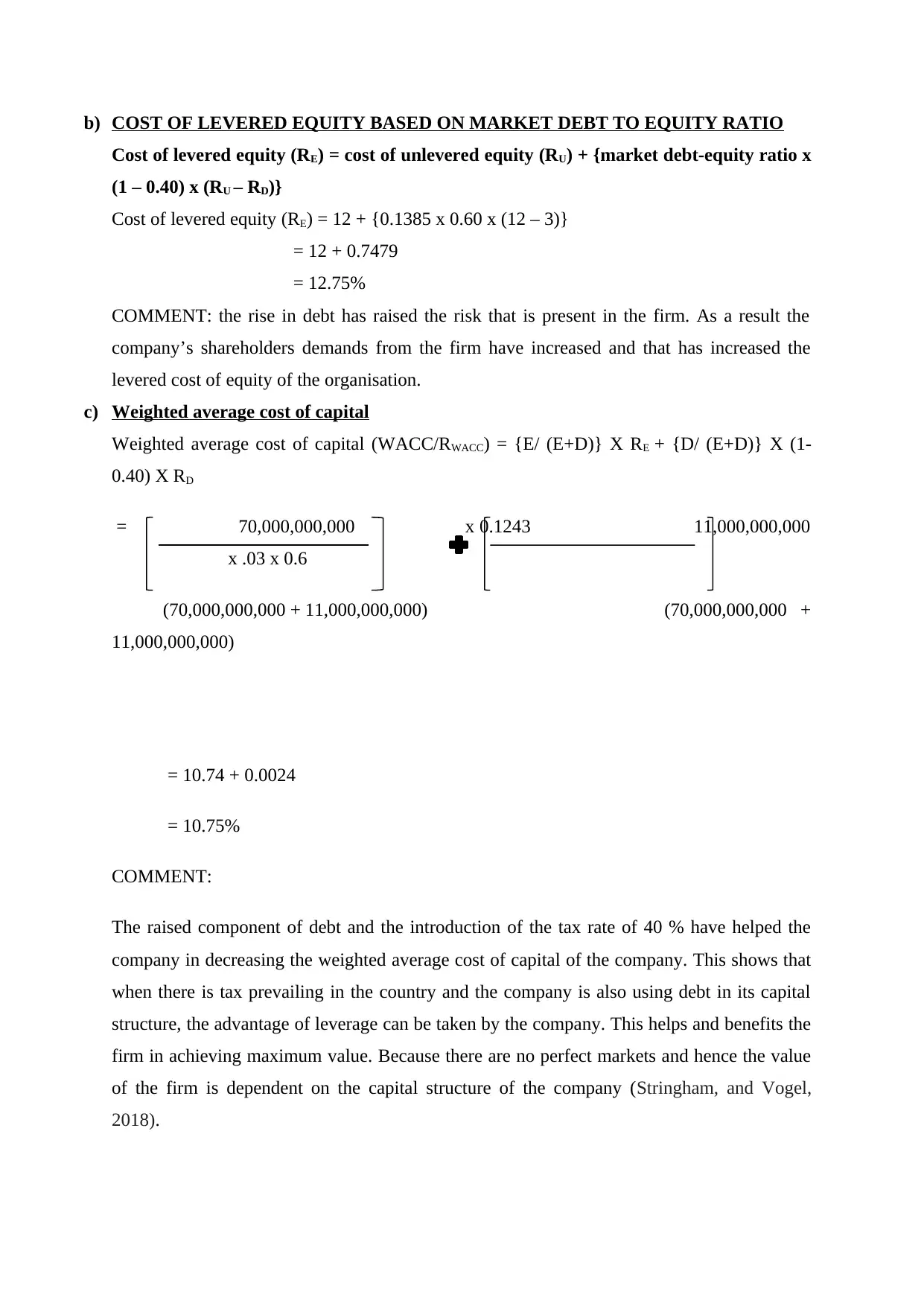
b) COST OF LEVERED EQUITY BASED ON MARKET DEBT TO EQUITY RATIO
Cost of levered equity (RE) = cost of unlevered equity (RU) + {market debt-equity ratio x
(1 – 0.40) x (RU – RD)}
Cost of levered equity (RE) = 12 + {0.1385 x 0.60 x (12 – 3)}
= 12 + 0.7479
= 12.75%
COMMENT: the rise in debt has raised the risk that is present in the firm. As a result the
company’s shareholders demands from the firm have increased and that has increased the
levered cost of equity of the organisation.
c) Weighted average cost of capital
Weighted average cost of capital (WACC/RWACC) = {E/ (E+D)} X RE + {D/ (E+D)} X (1-
0.40) X RD
= 70,000,000,000 x 0.1243 11,000,000,000
x .03 x 0.6
(70,000,000,000 + 11,000,000,000) (70,000,000,000 +
11,000,000,000)
= 10.74 + 0.0024
= 10.75%
COMMENT:
The raised component of debt and the introduction of the tax rate of 40 % have helped the
company in decreasing the weighted average cost of capital of the company. This shows that
when there is tax prevailing in the country and the company is also using debt in its capital
structure, the advantage of leverage can be taken by the company. This helps and benefits the
firm in achieving maximum value. Because there are no perfect markets and hence the value
of the firm is dependent on the capital structure of the company (Stringham, and Vogel,
2018).
Cost of levered equity (RE) = cost of unlevered equity (RU) + {market debt-equity ratio x
(1 – 0.40) x (RU – RD)}
Cost of levered equity (RE) = 12 + {0.1385 x 0.60 x (12 – 3)}
= 12 + 0.7479
= 12.75%
COMMENT: the rise in debt has raised the risk that is present in the firm. As a result the
company’s shareholders demands from the firm have increased and that has increased the
levered cost of equity of the organisation.
c) Weighted average cost of capital
Weighted average cost of capital (WACC/RWACC) = {E/ (E+D)} X RE + {D/ (E+D)} X (1-
0.40) X RD
= 70,000,000,000 x 0.1243 11,000,000,000
x .03 x 0.6
(70,000,000,000 + 11,000,000,000) (70,000,000,000 +
11,000,000,000)
= 10.74 + 0.0024
= 10.75%
COMMENT:
The raised component of debt and the introduction of the tax rate of 40 % have helped the
company in decreasing the weighted average cost of capital of the company. This shows that
when there is tax prevailing in the country and the company is also using debt in its capital
structure, the advantage of leverage can be taken by the company. This helps and benefits the
firm in achieving maximum value. Because there are no perfect markets and hence the value
of the firm is dependent on the capital structure of the company (Stringham, and Vogel,
2018).
Paraphrase This Document
Need a fresh take? Get an instant paraphrase of this document with our AI Paraphraser
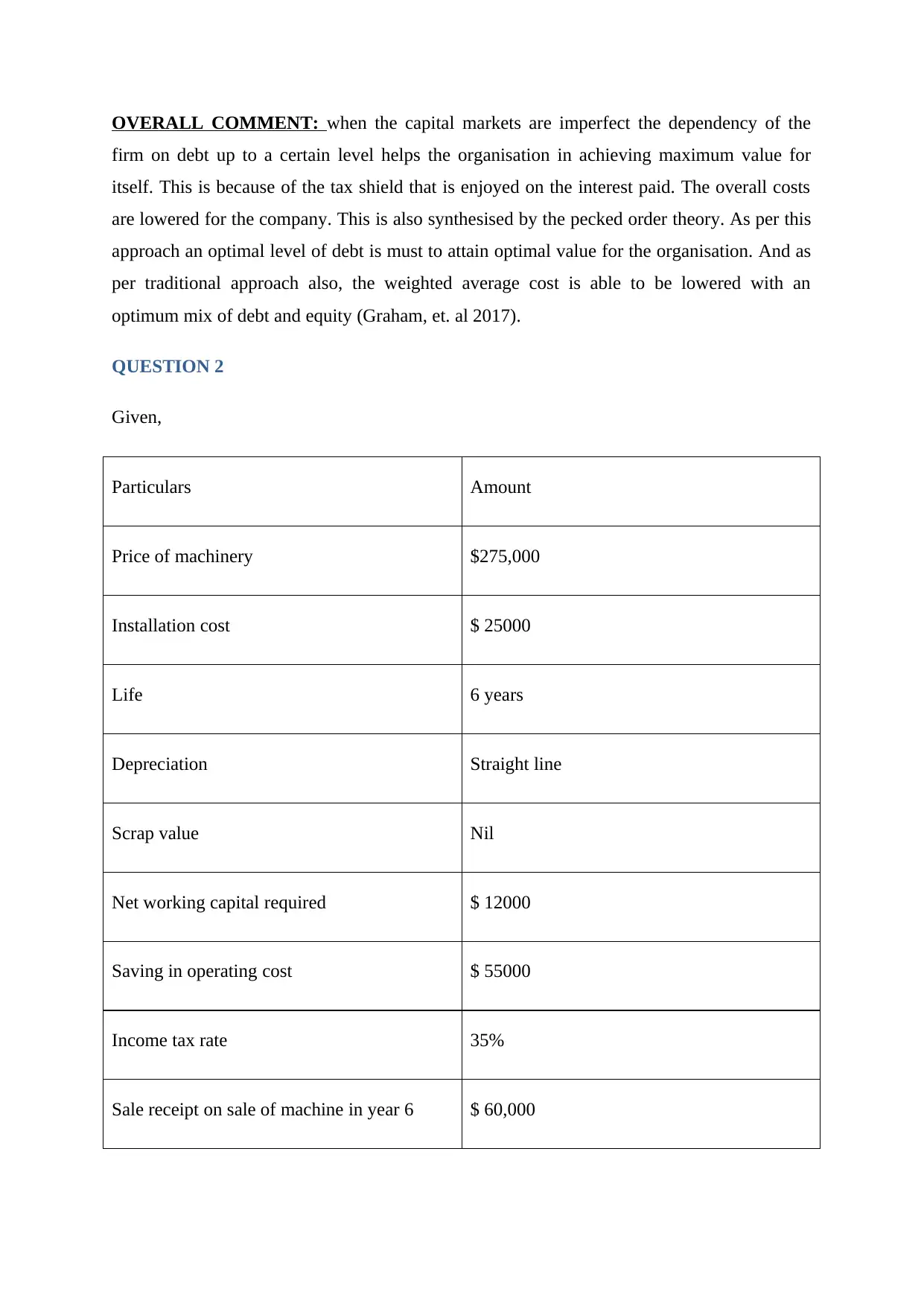
OVERALL COMMENT: when the capital markets are imperfect the dependency of the
firm on debt up to a certain level helps the organisation in achieving maximum value for
itself. This is because of the tax shield that is enjoyed on the interest paid. The overall costs
are lowered for the company. This is also synthesised by the pecked order theory. As per this
approach an optimal level of debt is must to attain optimal value for the organisation. And as
per traditional approach also, the weighted average cost is able to be lowered with an
optimum mix of debt and equity (Graham, et. al 2017).
QUESTION 2
Given,
Particulars Amount
Price of machinery $275,000
Installation cost $ 25000
Life 6 years
Depreciation Straight line
Scrap value Nil
Net working capital required $ 12000
Saving in operating cost $ 55000
Income tax rate 35%
Sale receipt on sale of machine in year 6 $ 60,000
firm on debt up to a certain level helps the organisation in achieving maximum value for
itself. This is because of the tax shield that is enjoyed on the interest paid. The overall costs
are lowered for the company. This is also synthesised by the pecked order theory. As per this
approach an optimal level of debt is must to attain optimal value for the organisation. And as
per traditional approach also, the weighted average cost is able to be lowered with an
optimum mix of debt and equity (Graham, et. al 2017).
QUESTION 2
Given,
Particulars Amount
Price of machinery $275,000
Installation cost $ 25000
Life 6 years
Depreciation Straight line
Scrap value Nil
Net working capital required $ 12000
Saving in operating cost $ 55000
Income tax rate 35%
Sale receipt on sale of machine in year 6 $ 60,000

a) INITIAL INVESTMENT OUTLAY
Initial investment outlay comprises of all the cost incurred on the purchase as well as on the
setting up and installing of the machinery in the entity premises. The working capital that is
required for the project is also considered as a part of the initial outlay (Gotze, Northcott, and
Schuster, 2016). This is the money that is required to do a project. These includes the money
that is required to purchase the product, its transportation and fixing charges and finally the
additional working capital that may be required as a result of the new equipment.
So, initial investment = 275,000 + 25,000 + 12000
= $ 312,000
b) TERMINAL CASH FLOW IN YEAR 6
Terminal cash flow is the amount of capital that the investor will get back as salvage
value after you dispose an item
Computation of a year’s cash flow:
Particulars Amount ($)
Savings in operating costs 55,000
Less: depreciation (275,000 + 25,000)/6 50,000
Operating profit before tax 5,000
Less: tax @ 35 % (5000 x 0.35) 1,750
Operating profit after tax 3,250
Add: depreciation 50,000
Initial investment outlay comprises of all the cost incurred on the purchase as well as on the
setting up and installing of the machinery in the entity premises. The working capital that is
required for the project is also considered as a part of the initial outlay (Gotze, Northcott, and
Schuster, 2016). This is the money that is required to do a project. These includes the money
that is required to purchase the product, its transportation and fixing charges and finally the
additional working capital that may be required as a result of the new equipment.
So, initial investment = 275,000 + 25,000 + 12000
= $ 312,000
b) TERMINAL CASH FLOW IN YEAR 6
Terminal cash flow is the amount of capital that the investor will get back as salvage
value after you dispose an item
Computation of a year’s cash flow:
Particulars Amount ($)
Savings in operating costs 55,000
Less: depreciation (275,000 + 25,000)/6 50,000
Operating profit before tax 5,000
Less: tax @ 35 % (5000 x 0.35) 1,750
Operating profit after tax 3,250
Add: depreciation 50,000
⊘ This is a preview!⊘
Do you want full access?
Subscribe today to unlock all pages.

Trusted by 1+ million students worldwide
1 out of 22
Related Documents
Your All-in-One AI-Powered Toolkit for Academic Success.
+13062052269
info@desklib.com
Available 24*7 on WhatsApp / Email
![[object Object]](/_next/static/media/star-bottom.7253800d.svg)
Unlock your academic potential
Copyright © 2020–2025 A2Z Services. All Rights Reserved. Developed and managed by ZUCOL.





